Everything You Need to Know About Grappa
Primary tabs
Grappa has been traditionally considered an Italian spirit that’s enjoyed at the end of a meal or with coffee. It was not something that you’d savor as a fine brandy or mix into a cocktail.
But grappa producers aim to change that perception with more refined products, experiments with aging the spirit and better promotion. As part of the Hello Grappa! Campaign, AssoDistil (the association of Italian distillers) earlier this year hosted a group of American journalists to tour the grappa-producing regions and learn more about how the spirit is made today.
Defining Grappa
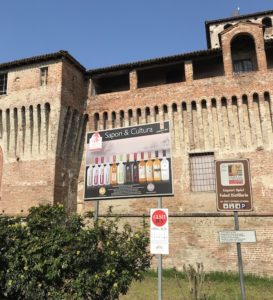
Fahled Distilleries is housed in the 15th-century Castle Roccabianca in the Parma region.
First off, grappa is created by distilling fermented or semi-fermented pomace—the grape skins, stalks and seeds that remain after the grape-pressing stage when making wine. The aromatic substances in the grape pomace contribute to grappa’s distinctive bouquet, producers say.
European Union law states that that the Grappa Geographical Indication (GI) exclusively applies to the pomace-based spirit produced from raw materials obtained from grapes produced and vinified in Italy, and distilled and processed in plants located in Italian territory. So other pomace distillates produced in the EU can’t be called grappa.
Grappa must have an alcohol content of no less than 37.5% by volume to be marketed for consumption. The grappa production and aging process is now highly regulated and bonded to ensure quality and consistency.
“Grappa is a very niche distillate that can only be made in Italy,” says Lisa Tosolini of the distillery Bepi Tosolini in the province of Udine. Her grandfather Bepi founded the company in 1943; Lisa and her brothers Guiseppe and Bruno run it today.
“You taste the spirit of the land, the family, the passion for the product,” Tosolini says. “That’s what’s different about grappa.”
Age Statements
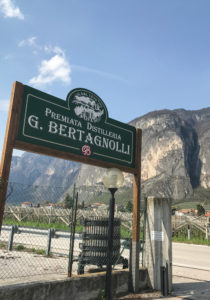
The oldest distillery in Trentino, Italy, Bertagnolli was founded in 1870 when the region was part of the Austro-Hungarian empire.
Early grappa was “a poor man’s way to recycle the grapes,” Tosolini notes. And those young grappas could be harsh. But the quality of the spirit has come a long way.
One reason is that producers have more control over the grape pomace; production processes have also improved in recent years. But the most significant development is the trend of aged grappa.
Fahled Distilleries in the Parma region has been aging some of its grappas since the 1950s. The company bought the 15th-century Castle Roccabianca in the late 1960s because the structure’s history and design was well suited to aging brandy and grappa.
But for the most part, grappa was not widely aged until fairly recently, says Mauro Piliu, export director of Distillerie Franciacorta in Italy’s Franciacorta region. “We thought the aging process would give more to the distillate,” he says.
Grappa was developed as a white product; aging is a recent development of the past 20 years, says Franco Bertagnolli, great-grandson of the founder of Bertagnolli Distillery. The oldest distillery in Trentino, Bertagnolli was founded in 1870 when the region was part of the Austro-Hungarian empire. “We think aging will enable a softer product that will appeal to other markets,” Bertagnolli says.
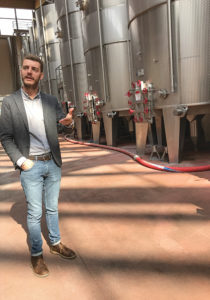
Alessandro Marzadro of the Marzadro Distillery in Trentino, explains the grappa production process.
For certain, grappa was not up to standard 20 years ago, so trying to promote the category would not have been possible, says Alessandro Marzadro. He’s the grandson of Attilio Marzadro, who had started the Marzadro Distillery in Trentino with his older sister Sabina in 1949. “But today we have a good product: Most of the time we surprise people with the quality of the grappa.”
The Marzadro Distillery began concentrating on aging grappa in 1999; 70% of the grappa it produces today is aged.
The distillery has different types of barrels and toasting levels including oak, acacia, ash and cherry. Some of the barrels were previously used to age port and sherry, Marzadro notes, which is a way to introduce whiskey drinkers to grappa.
Cognac Comparisons
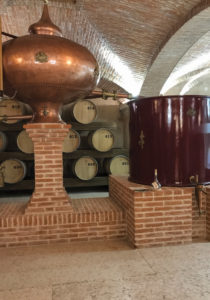
Distillerie Franciacorta’s distilling system purchased from Cognac house Hennessey.
Grappa’s transformation into a higher-end, aged spirit of provenance brings comparison to Cognac. In fact, Distillerie Franciacorta purchased a distilling system from Hennessey for producing its spirits.
Roberto Castagner, who founded the Acquavite Distillery in Treviso in 1996, loved Cognac and dreamed of creating something similar for the grappa category. “He thought it was important from the beginning to invest in a barrique cellar for aging,” says Roberto’s daughter Guila Castagner, who with her sister Silvia and cousin Carlo help run the business.
The distillery started out producing grappa for others; Roberto Castagner decided to produce his own brand in 2000. “He thought that barrique grappa was going to be the future, and he was right,” Guila Castagner says. About 90% of the grappa produced by Acquavite today is aged.
Aging the spirit “could be the future of grappa,” Marzadro says. And through aged grappa, “we think we can get people into white grappa.’’
But he thinks it’s important to not go overboard with aging so much that you lose the flavor of the grappa. “There’s no point in making a grappa that doesn’t taste like a grappa,” Marzadro notes.
Cocktails and Consumer Awareness
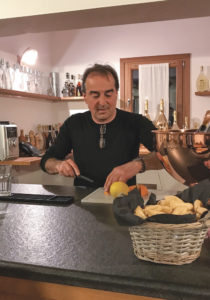
Sandro Bottega, director of Distilleria Bottega in Trentino mixing up some grappa cocktails.
There are a number of hurdles to getting consumers into grappa. One is the perception that it’s only a digestif, notes Bertagnolli. “We have to look at other ways to serve grappa to appeal to new customers,” he says, from serving it in a special whiskey glass to offering it with ice or mixing into a cocktail.”
Many producers, including Distilleria Bottega in Trentino, promote grappa cocktails. Director Sandro Bottega shared his recipe for the Mediteranneo grappa cocktail: Muddle a quarter wedge of lemon, a quarter wedge of lime with a teaspoon of brown sugar in a rocks glass. Add 1 oz. of grappa and a splash limoncello. Top with prosecco and garnish with a basil sprig.
Distillerie Bonollo Umberto in 2016 partnered with entrepreneur Luca Fabris to create Gra’it, a grappa brand designed for cocktails. Gra’it uses seven Italian wine grapes—sangiovese, nebbiolo, moscato d’asti, corvina, glera, aglianico and nero d’avola—to create a blended distillate that’s aged for 12 months in Slavonian oak casks, resulting in a smooth, flavorful and cocktail-friendly spirit.
In addition to cocktails, education is key to expanding the grappa. The Marzadro Distillery began holding classes two years ago to teach people about the spirit.
It’s important to bring the product and education to others, Marzadro says. “Most producers don’t go out into the market and talk to customers. If bartenders don’t know about grappa, they won’t suggest grappa.”
Melissa Dowling is editor of our on-premise sister publication Cheers magazine. Reach her at mdowling@epgmediallc.com.
- Log in to post comments
- 4905 reads
